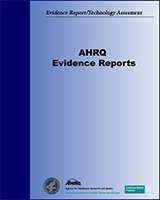This publication is provided for historical reference only and the information may be out of date.
Update on Acute Bacterial Rhinosinusitis
Evidence Reports/Technology Assessments, No. 124
Authors
Investigators: Stanley Ip, MD, Linda Fu, MD, Ethan Balk, MD, MPH, Priscilla Chew, MPH, Deirdre DeVine, MLitt, and Joseph Lau, MD.ReadStructured Abstract
Context:
Our last report on the treatment of acute bacterial sinusitis was published in 1999. Since then, many more trials were published comparing different antibiotics not found in the previous report. In addition, universal pneumococcal vaccination was introduced in the pediatric population. It is of interest to examine the effects of these new developments on the treatment of acute bacterial rhinosinusitis.
Objectives:
To perform a systematic review of the literature published since 1997 on comparisons of antibiotics in the treatment of acute bacterial rhinosinusitis, to summarize the adverse events and note any reported impact of pneumococcal vaccine on the treatment of acute bacterial rhinosinusitis.
Data Sources:
We searched the MEDLINE® database and bibliographies of selected reviews. Additional studies were provided by technical experts.
Study Selection:
English-language, comparative trials of antibiotics for the treatment of acute bacterial rhinosinusitis in both adult and pediatric populations were included. Studies of sinusitis with complications or that included both subjects with sinusitis and subjects with other respiratory tract infections were excluded.
Data Extraction:
We extracted information about the study design, demographics, eligibility criteria, antibiotic dosing regimens, outcome measures, including dropouts, and adverse events. Based on these data, studies were graded for quality.
Data Synthesis:
Thirty-nine randomized controlled trials from 1997 to 2004 met the inclusion criteria for this report. With the exception of 5 studies that did not provide the information, all studies were either funded by pharmaceutical companies or had authors associated with the pharmaceutical industry. Only one study exclusively evaluated pediatric population. The trials evaluated pencillins, cephalosporins, macrolides, azalides, ketolides, quinolones, carbapenems and tetracyclines. In 5 placebo-controlled trials, antibiotics were more effective than placebo, reducing the risk of clinical failure by about 25–30 percent 7 to 14 days after treament initiation. Compared to amoxicillin/clavulanate, treatment with cephalosporins result in about 3.5 more clinical failures per 100 patients at 10–25 days after treatment initiation. There was no consistent difference observed when comparing amoxcillin-clavulanate, cephalosporins and quinolones to the group encompassing macrolides, azalides and ketolide.
Eight studies that evaluated different treatment durations generally found no differences in efficacy outcomes between the shorter and longer duration therapies.
Thirty-four of the comparative trials and five additional non-comparative studies reported adverse events. Descriptions of adverse events were diverse among studies. It was not possible to make meaningful comparisons of adverse event rates across different antibiotic classes given the large variation in the adverse event rates within the same antibiotic class. Overall, the most common adverse events involved the gastrointestinal and the nervous system (such as headache). We did not identify any article in our literature search that directly addressed the impact of pneumococcal vaccine on the treatment of acute bacterial rhinosinusitis.
Conclusions:
About two-thirds of the patients with acute rhinosinusitis receiving placebos recovered without antibiotics. Antibiotics are superior to placebo in the treatment of rhinosinusitis. Amoxicillin/clavulanate is more effective than the cephalosporin class of antibiotics in the treatment of sinusitis only in the short-term follow up, with an absolute risk difference of about 3.5 percent.
There are only a few studies that specifically examined the effect of different treatment duration on outcome efficacy; they generally found no difference between shorter and longer duration of treatment. It is not possible to compare the rates of adverse events across different antibiotic classes. Severe adverse events in general are uncommon; they occurred in up to about 3.5 percent of patients in all classes of antibiotics.
As of September 2004, there have not been any published studies examining the effect of the pneumococcal vaccine on the treatment of acute sinusitis.
A minority of studies were placebo controlled. In addition, from a health care cost standpoint, there were very few comparative studies between newer antibiotics and older inexpensive ones (like amoxicillin and trimethoprim/sulfamethoxazole).
Prepared for: Agency for Healthcare Research and Quality, U.S. Department of Health and Human Services.1 Contract No. 290-02-0022. Prepared by: Tufts-New England Medical Center EPC, Boston, Massachusetts.
Suggested citation:
Ip S, Fu L, Balk E, Chew P, DeVine D, Lau J. Update on Acute Bacterial Rhinosinusitis. Evidence Report/Technology Assessment No. 124. (Prepared by Tufts-New England Medical Center Evidence-based Practice Center under Contract No. 290-02-0022). AHRQ Publication No. 05-E020-2. Rockville, MD: Agency for Healthcare Research and Quality. June 2005.
This report may be used, in whole or in part, as the basis for development of clinical practice guidelines and other quality enhancement tools, or a basis for reimbursement and coverage policies. AHRQ or U.S. Department of Health and Human Services endorsement of such derivative products may not be stated or implied.
AHRQ is the lead Federal agency charged with supporting research designed to improve the quality of health care, reduce its cost, address patient safety and medical errors, and broaden access to essential services. AHRQ sponsors and conducts research that provides evidence-based information on health care outcomes; quality; and cost, use, and access. The information helps health care decisionmakers—patients and clinicians, health system leaders, and policymakers— make more informed decisions and improve the quality of health care services.
The authors of this report are responsible for its content. Statements in the report should not be construed as endorsement by the Agency for Healthcare Research and Quality or the U.S. Department of Health and Human Services of a particular drug, device, test, treatment, or other clinical service.
- 1
540 Gaither Road, Rockville, MD 20850. www
.ahrq.gov
